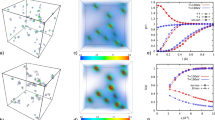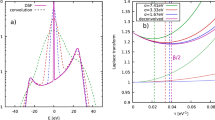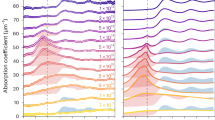Abstract
One of the grand challenges of contemporary physics is understanding strongly interacting quantum systems comprising such diverse examples as ultracold atoms in traps, electrons in high-temperature superconductors and nuclear matter1. Warm dense matter, defined by temperatures of a few electron volts and densities comparable with solids, is a complex state of such interacting matter2. Moreover, the study of warm dense matter states has practical applications for controlled thermonuclear fusion, where it is encountered during the implosion phase3, and it also represents laboratory analogues of astrophysical environments found in the core of planets and the crusts of old stars4,5. Here we demonstrate how warm dense matter states can be diagnosed and structural properties can be obtained by inelastic X-ray scattering measurements on a compressed lithium sample. Combining experiments and ab initio simulations enables us to determine its microscopic state and to evaluate more approximate theoretical models for the ionic structure.
This is a preview of subscription content, access via your institution
Access options
Subscribe to this journal
Receive 12 print issues and online access
269,00 € per year
only 22,42 € per issue
Buy this article
- Purchase on SpringerLink
- Instant access to full article PDF
Prices may be subject to local taxes which are calculated during checkout





Similar content being viewed by others
References
National Research Council. Frontiers in High Energy Density Physics : The X-Games of Contemporary Science (National Academies Press, 2003).
Ichimaru, S. Strongly coupled plasmas: High-density classical plasmas and degenerate electron liquids. Rev. Mod. Phys. 54, 1017–1059 (1982).
Lindl, J. Development of the indirect-drive approach to inertial confinement fusion and the target physics basis for ignition and gain. Phys. Plasmas 2, 3933–4024 (1995).
Guillot, T. Interiors of giant planets inside and outside the solar system. Science 286, 72–76 (1999).
Vocadlo, L. et al. Possible thermal and chemical stabilization of body-centered-cubic iron in the Earth’s core. Nature 424, 536–539 (2003).
Koenig, M. et al. Progress in the study of warm dense matter. Plasma Phys. Control. Fusion 47, B441–B449 (2005).
Rygg, J. R. et al. Proton radiography of inertial fusion implosions. Science 319, 1223–1225 (2008).
Glenzer, S. H. et al. Demonstration of spectrally resolved x-ray scattering in dense plasmas. Phys. Rev. Lett. 90, 175002 (2003).
Glenzer, S. H. et al. Observations of plasmons in warm dense matter. Phys. Rev. Lett. 98, 065002 (2007).
Ravasio, A. et al. Direct observation of strong ion coupling in laser-driven shock-compressed targets. Phys. Rev. Lett. 99, 135006 (2007).
Chihara, J. Difference in x-ray scattering between metallic and non-metallic liquids due to conduction electrons. J. Phys. Condens. Matter 12, 231–247 (2000).
Gregori, G., Ravasio, A., Höll, A., Glenzer, S. H. & Rose, S. J. Derivation of static structure factor in strongly coupled non-equilibrium plasmas for x-ray scattering studies. High Energy Density Phys. 3, 99–108 (2007).
Kresse, G. & Hafner, J. Ab-initio molecular-dynamics for liquid-metals. Phys. Rev. B 47, RC558–RC561 (1993).
Kresse, G. & Hafner, J. Ab-initio molecular-dynamics simulation of the liquid-metal amorphous–semiconductor transition in germanium. Phys. Rev. B 49, 14251–14269 (1994).
Kresse, G. & Furthmüller, J. Efficient iterative schemes for ab initio total-energy calculations using a plane-wave basis set. Phys. Rev. B 54, 11169–11186 (1996).
Sawada, H. et al. Diagnosing direct-drive, shock-heated, and compressed plastic planar foils with non-collective spectrally resolved x-ray scattering. Phys. Plasmas 14, 122703 (2007).
Izvekov, S., Parinello, M., Burnham, C. J. & Voth, G. A. Effective force fields for condensed phase systems from ab initio molecular dynamics simulation: A new method for force-matching. J. Chem. Phys. 120, 10896–10913 (2004).
Hone, T. D., Izvekov, S. & Voth, G. A. Fast centroid molecular dynamics: A force-matching approach for the predetermination of the effective centroid forces. J. Chem. Phys. 122, 054105 (2005).
Wünsch, K., Hilse, P., Schlanges, M. & Gericke, D. O. Structure of strongly coupled multicomponent plasmas. Phys. Rev. E. 77, 056404 (2008).
Danson, C. N. et al. Well characterized 1019 W cm−2 operation of VULCAN—an ultra-high power Nd:glass laser. J. Mod. Opt. 45, 1653–1669 (1998).
Paterson, I. J. et al. Image plate response for conditions relevant to laser–plasma interaction experiments. Meas. Sci. Technol. 19, 095301 (2008).
Pak, A. et al. X-ray line measurements with high efficiency Bragg crystals. Rev. Sci. Instrum. 75, 3747–3749 (2004).
Osborn, K. D. & Callcott, T. A. Two new optical designs for soft x-ray spectrometers using variable-linespace gratings. Rev. Sci. Instrum. 66, 3131–3136 (1995).
MacFarlane, J. J. et al. HELIOS-CR—A 1D radiation-magnetohydrodynamics code with inline atomic kinetics modeling. J. Quant. Spectrosc. Radiat. Transfer 99, 381–397 (2006).
Kresse, G. & Joubert, D. From ultrasoft pseudopotentials to the projector augmented-wave method. Phys. Rev. B 59, 1758–1775 (1999).
Mermin, N. D. Thermal properties of the inhomogeneous electron gas. Phys. Rev. 137, A1441–A1443 (1965).
Blöchl, P. E. Projector augmented-wave method. Phys. Rev. B 50, 17953–17979 (1994).
Perdew, J. P., Burke, K. & Ernzerhof, M. Generalized gradient approximation made simple. Phys. Rev. Lett. 77, 3865–3868 (1996).
Hoover, W. G. Canonical dynamics: Equilibrium phase-space distributions. Phys. Rev. A 31, 1695–1697 (1985).
Van Leuwen, J. M. J., Groenveld, J. & DeBoer, J. New method for the calculation of the pair correlation function. Physica 25, 792–808 (1959).
Acknowledgements
This work was partially supported by EPSRC grants and by the Science and Technology Facilities Council of the United Kingdom. Additional support from the US DOE and the Lawrence Livermore National Laboratory is also acknowledged. We thank the Vulcan operation, engineering and target fabrication groups for their support during the experiment.
Author information
Authors and Affiliations
Contributions
E.G.S., G.G., B.B., R.J.C., F.Y.K., M.M.N., A.P., R.L.W. and D.R. carried out the Vulcan experiment. E.G.S., G.G., S.H.G., P.N., A.P., D.P., M.R. and M.S. carried out preparatory experiments and diagnostics development at the Lawrence Livermore National Laboratory. E.G.S., G.G., F.Y.K. and D.R. analysed the data. E.G.S., G.G. and D.O.G. wrote the paper. The simulations were carried out by D.O.G., J.V. and K.W. C.S. and G.G. designed targets used in the experiment. R.R.F., S.H.G., M.K., O.L.L., D.N., M.R. and L.v.W. provided additional experimental and theoretical support. G.G., S.H.G. and D.R. conceived the project in this paper.
Corresponding author
Rights and permissions
About this article
Cite this article
García Saiz, E., Gregori, G., Gericke, D. et al. Probing warm dense lithium by inelastic X-ray scattering. Nature Phys 4, 940–944 (2008). https://doi.org/10.1038/nphys1103
Received:
Accepted:
Published:
Issue Date:
DOI: https://doi.org/10.1038/nphys1103
This article is cited by
-
X-ray Thomson scattering absolute intensity from the f-sum rule in the imaginary-time ___domain
Scientific Reports (2024)
-
A strong diffusive ion mode in dense ionized matter predicted by Langevin dynamics
Nature Communications (2017)
-
Theory of Thomson scattering in inhomogeneous media
Scientific Reports (2016)
-
X-ray scattering measurements of dissociation-induced metallization of dynamically compressed deuterium
Nature Communications (2016)
-
Linear dependence of surface expansion speed on initial plasma temperature in warm dense matter
Scientific Reports (2016)



